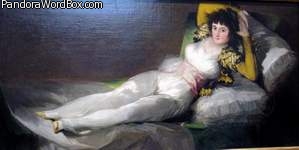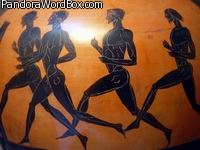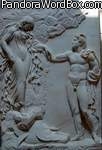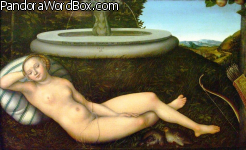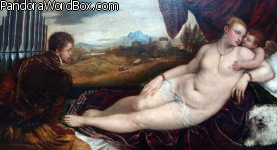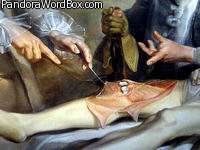One starting point may be a FEMININE HIP as the anchor of a THICK THIGH, thus the FEMUR, which are a source of characteristic FEMININE curvatious contours. Granted that omitted here will be the populistic notions inherent in HIP HYPE HIPSTER or even HIPPY.
Therefore, the agenda here is to deal with feminine CURVATIOUS HIPs and THIGHs, including their impact on masculine psyches. Please note that other companion overviews also concern notions in HIP and THIGH as components of animal locomotor systems. In brief, we will start by agreeing with Mr. N. Webster, who defined CURVE and CURVACEOUS as:
"A well proportioned Feminine Figure".
"Feminine" defines "Curvatious"
In Italian and Latin, the thigh is GAMBa and FEMUR and both are given as feminine. These concepts are inherent in GAMBit as in GAMBle, as well as to VIOLa di GAMBA, a musical instrument held between the thighs.
The story about the affair of Zeus with Danae is to remind the mortals how THIGHS can unleash dramatic consequences ... apparently Zeus was able to induce Danae to spread her thighs to receive him disguised as a shower of gold ... Apuleius popularized this story and coined the term INTERFEMINIUM to refer to the virtual space between FEMINine thighs, or FEMORA, thus avoiding to mention the name of such intimate female anatomy. In any case, Danae who was considered IMPREGNABLE, became PREGNANT, had a son named PERSEUS from a pregnancy by per-ZEUS - and so arose PERSIA.
Gold impregnated impregnable Danae.
Thighs can inflame desires
Mundane and Profane Danae
The Roman vocabulary added unique nuances to THIGH or FEMORAL region by naming the outer and inner thigh areas as FEMAR and FEMEN respectively. FEMEN or FEMELLA stood for "the lady of the house" and imply a link with the sensual intimate inner surfaces of the FEMEN thighs. FAMULA and FAMULAE stood to house servants and who were devoid of erotic household implications. Perhaps, modern FEMINISTS need a reminder of these facts. Presumably, in Roman times, female human house-servants were not seen by males maters as sexual objects. In short, DAME and MAID underscore the control of the former over FAMILY and the irrelevance of FAMULA in matters of the FAMILY but ... perhaps NOT so ... countless Roman era cemetery "lapidas" or stone tablets are preserved denoting the devotion and love of family members toward their FAMULAE or "maids".
In any case, biologic imperatives to perpetuate "man"- kind persist and males will continue to be attracted to FEMININE FEMORA and PHEMI in the full sense of these word-ideas. Feminists should note that the ancients added to PHEMI the additional notion of LOCUACITY through soft and gracious speech. From PHEMI we learn more about PHONE, PHONETICS and all of their tele-PHONIC derivatives. If you do not believe this perspective, remember that Sapho, Cleopatra, Roxalana, Mata Hari, Lola Montez, and so many other "FEMME FATAL" were not particularly beautiful but their PHEMI was rooted in their charming declamations. To better grasp the above, perhaps LACONIC, pointing toward LACONIA, the area in Greece of the Spartans, underscores that Spartan males were expected to be succinct, while ladies were expected to speak softly and persuasively and that was their main weapon to dominate males as domestic FEMAS and masters of the DOMICILE of the FAMILY.
FEMINST should learn about the contrasts implicit in
FAMULA, FEMINA and PHEMI.
There are others who underscore that men and females are seduced differently; men by feminine curves and eyes and women by their ears.
Hips and Thighs sustain Muscular Motion.
From the MASCULINE perspective, THIGH in Spanish is MUSLO which points toward NUS, MUSCULUS, MIASO, MASCULINE. The tale is that contracting muscles under the skin are reminiscent of mice or MUS running under a carpet. Miaso in Ukrainian denotes flesh.
Andromeda had feminine curves.
Perseus had masculine muscles.
MASculine MUS or MICe are MUScular.
A muscular THIGH is indeed THICK as is the thickest of fingers or THUMB. In the interest of brevity, the series THICK, THUMB, THIGH as in SWOLLEN, ENGORGED, TURGOR, TUMOR, TUBER, TUBERCULOSIS, enTOMBed or in Spanish TUMBA or in Greek TUMBOS for "swollen ground" of a fresh TOMB, are explored separately.
Feminine thighs are less muscular and (nonetheless) thicker than masculine ones.
Further and more recent emotional impact of the notions in HIP - THIGH deserve additional attention. Hip GYRAtions induced by walking, running, dancing or otherwise, give rise to a vast repertoire dealing with dance and sexuality - for example, dancers of the Argentine TANGo are expected to demonstrate GYRAting hips and thighs with and emphasis on TANGENT, implying barely touching between dancers. Another TANGent that also emerged in Buenos Aires, are women who GYRAte their hips - known as GIRA are those who do so for money, a euphemisms for prostitute. A similar twist in meanings exists for CURVE - in Ukrainian, CURVA, like the GIRA, is a woman swaying CURVAcious hips - in Italian, the same applies to GAMBERRA flaunting curvatious GAMBAS or THIGHS.
FEMinine FEMurs and PHEMI and be
FETAL and FATAL weapons of a FEMME FATAL
Only few "Femme Fatal" gained power solely by swaying hips.
To TANGo calls for GIRAting hips and GAMBAS or thighs - oneTANGential way to promote pairing. (Pene du Bois; Hopper)
A more JOCULAR panorama emerges when those who are obese JIGgle their softened tissues. To JOG can also shake GLUTeal regions as can dancing a JIG. Perhaps JIGGling fatty GLUTeal regions may prevent GLUTtony and encourage avoidance of GLUT for GLUTEN and GLUCOSE.
In some cultures steato pygia (fat-butt) is a sign of Callipygia
(A better known and admired woman is Aphrodite Callipyge -Kallos (beauty) is also found in many other names including California)
Finally, curve and curvaceous or KAMPE or KAMPA in Indo-European, point to KNEE or KOLINO in Ukrainian, as well as to inCLINE, deCLINE and CLINIC - matters exposed in a companion overview.
Knees have a "cap" or patella, a sesamoid bone
shaped like a sesame seed.
20101024 - 20160716 ww






